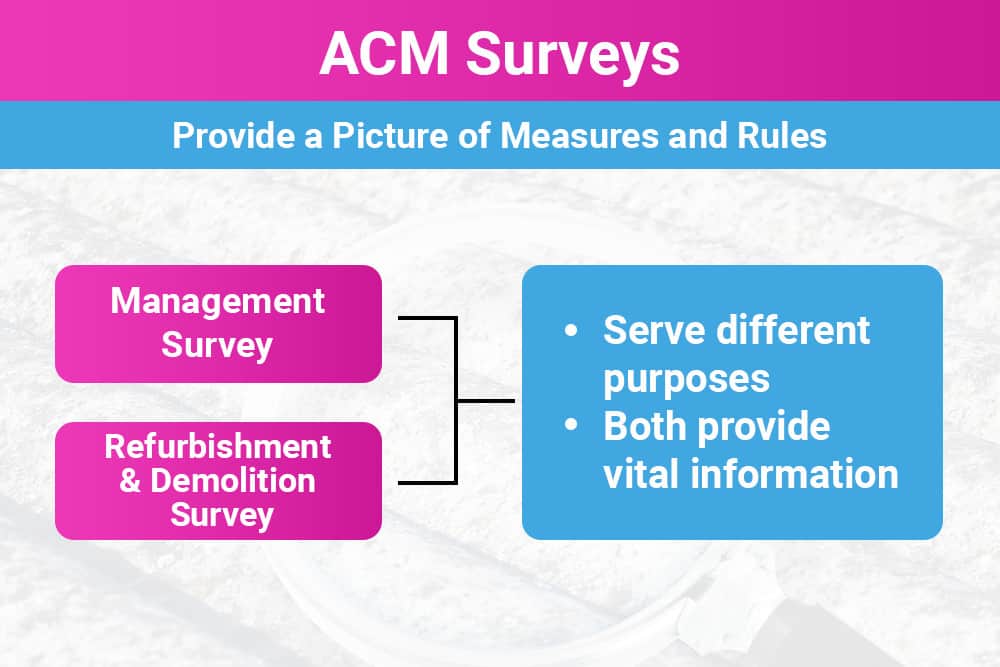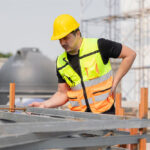
To mitigate the risks posed by asbestos containing materials (ACMs), the Health and Safety Executive (HSE) released a document entitled Asbestos: The Survey Guide in 2010 (later updated in 2012). This guide details the obligation of all duty holders to perform an asbestos survey on any structure where there is the possibility of ACMs being present.
Alongside the requirements stipulated in the Control of Asbestos Regulations 2012, asbestos surveys are a crucial aspect of staying safe on any site that may have ACMs present. It is important that any person or employer that conducts activities that may disturb ACMs, such as construction work, is aware of the different types of asbestos surveys and what they are used for.
The Purpose of an Asbestos Survey
Surveys are key tools for developing an asbestos management plan and performing risk assessments in any workplace where there might be asbestos present.
The main purpose of an asbestos survey is to provide accurate information on the location, quantity, and condition of any ACMs in the area. An asbestos survey is used to assess any damage or deterioration in ACMs and determine whether remedial work is required.
Asbestos surveys provide the necessary data to prepare an asbestos register and an asbestos plan for the building or buildings. They help identify all ACMs that have to be removed before any demolition or refurbishment work commences.
Who Can Conduct an Asbestos Survey
ACM surveys of buildings must only be undertaken by those who are competent to do so.
This means that they are:
- Knowledgeable of surveys and the risks
- Adequately trained and experienced
- Able to use an effective quality management system
- Able to demonstrate integrity, independence and integrity
- Able to work in accordance with government guidance
Anyone conducting an ACM survey will need to know exactly what they are looking for. Asbestos can be present in a wide range of materials from insulation to tiling and flooring materials.
Surveys can disturb asbestos fibres, which poses an immediate hazard to anyone in the vicinity. For this reason, it is vital that the person(s) performing the survey are trained on how to avoid the accidental release of asbestos fibres into the air.
The Types of Asbestos Surveys
There are two primary types of surveys that can help to provide a clearer picture of the measures and rules which need to be applied to a particular worksite. The two survey categories are:
- The asbestos management survey
- The asbestos refurbishment survey and asbestos demolition survey
While these two survey types serve different purposes, both provide information that is critical in maintaining asbestos safety protocols, and are in accordance with UK health and safety regulations and legislation.

The Asbestos Management Survey
This is the most common type of survey and is widely used across the UK.
- It is intended to identify any ACMs that could be disturbed during normal occupancy of a building or by routine activities, such as maintenance and installation work.
- It usually involves only minor disturbances of ACMs.
- It provides an initial guide to the priority for managing ACMs by identifying the materials which will most readily release airborne fibres if they are disturbed.
- Typically, it involves sampling and analysis to confirm the presence or absence of ACMs.
However, it is often the case that it will be carried out on the assumption that ACMS are present in the building or buildings.
When conducting this survey, all areas of a building or buildings should be accessed and assessed as far as is reasonably possible. Any areas that cannot be reached will be detailed by the surveyor. Photographs will be taken of all ACMs to be used in the compilation of a report that will also detail the condition of the ACMs and their potential for fibre release.
The Management Survey Report
After completion of the survey, a management survey report must be completed. An asbestos management survey report will usually contain the following sections:
- An introduction
- The executive summary
- General information on the site
- The results of the survey
- A risk assessment of all ACMs found
- The results of bulk analysis
- A certificate of analysis
- Photographs of the building or buildings
- Details of areas that could not be accessed
- Conclusions and actions required to be taken
- Detailed plans for ACM management
The Asbestos Refurbishment Survey and Asbestos Demolition Survey
An asbestos refurbishment survey or an asbestos demolition survey must be undertaken before any refurbishment or demolition work is carried out on a building. These surveys may also be required for intrusive maintenance and repair work, for example, the removal or dismantling of plant or equipment.
The primary aim of this survey is to identify all ACMs in a building, so that they can be removed prior to work commencing. To achieve this, the surveyors must be able to gain access to all areas to check for ACMs when conducting this survey. The surveyor cannot make any presumptions about the presence or absence of ACMs.
What is ‘Destructive Inspection’?
During the survey, the surveyor will review where work will be carried out and make note of what areas will be damaged or how the damage has occurred. The surveyor will actively destroy materials to check their content. This process is known as a ‘destructive inspection’.
A destructive inspection can involve the surveyor damaging large parts of a building. Only buildings that are being completely demolished should have this survey done.
An asbestos refurbishment survey still involves breaking materials or inspecting them using bore scopes, but the extent of the damage done is much less. Areas that are not due to be refurbished will not be inspected or damaged.
A destructive inspection will typically involve lifting carpets and tiles or breaking through walls and ceilings. These surveys may release asbestos and so need to be carefully controlled.
The Importance of Asbestos Awareness Training
ACMs pose a significant health hazard to any person involved in building maintenance refurbishment, demolition or construction work. Participating in accredited asbestos safety training can ensure that staff understand the hazards associated with asbestos.
Asbestos training gives trainees the skills to be able to recognise ACMS, know what safety measures to take to avoid asbestos and what to do if someone comes into close contact with ACMs.
Human Focus offers free asbestos posters and infographics as well as a range of asbestos awareness training courses. These courses are available to be taken online in bite-sized segments, so they can easily be completed in accordance with work schedules. The Human Focus asbestos awareness courses are fully accredited by respected authorities such as the UK Asbestos Training Association (UKATA) and Independent Asbestos Training Providers (IATP).


















































































































































































































































































































































































































































































































































































































































































































































